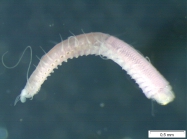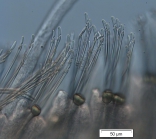WoRMS taxon details
Streptodonta San Martín & Hutchings, 2006
238206 (urn:lsid:marinespecies.org:taxname:238206)
accepted
Genus
Opisthodonta pterochaeta Southern, 1914 accepted as Streptodonta pterochaeta (Southern, 1914) (type by original designation)
marine, brackish, fresh, terrestrial
recent only
San Martín G. and Hutchings P.A.. 2006. Eusyllinae (Polychaeta, Syllidae) from Australia with the description of a new genus and fifteen new species. Records of the Australian Museum. 58. 257-370., available online at https://doi.org/10.3853/j.0067-1975.58.2006.1466
page(s): 353 [details]
page(s): 353 [details]
Etymology The name of the new genus is a combination of the prefix streptos, from the Greek, meaning twisted (in reference to...
Etymology The name of the new genus is a combination of the prefix streptos, from the Greek, meaning twisted (in reference to Streptosyllis), and the sufix donta (in reference to Opisthodonta), as the genus shares characters of both genera, thick, enlarged aciculae, like those present in Streptosyllis and a posterior pharyngeal tooth, like those present in Opisthodonta. [details]
Read, G.; Fauchald, K. (Ed.) (2024). World Polychaeta Database. Streptodonta San Martín & Hutchings, 2006. Accessed through: World Register of Marine Species at: https://www.marinespecies.org/aphia.php?p=taxdetails&id=238206 on 2024-04-16
Date
action
by
![]() The webpage text is licensed under a Creative Commons Attribution 4.0 License
The webpage text is licensed under a Creative Commons Attribution 4.0 License
original description
San Martín G. and Hutchings P.A.. 2006. Eusyllinae (Polychaeta, Syllidae) from Australia with the description of a new genus and fifteen new species. Records of the Australian Museum. 58. 257-370., available online at https://doi.org/10.3853/j.0067-1975.58.2006.1466
page(s): 353 [details]
page(s): 353 [details]
 Present
Present  Inaccurate
Inaccurate  Introduced: alien
Introduced: alien  Containing type locality
Containing type locality
From editor or global species database
Etymology The name of the new genus is a combination of the prefix streptos, from the Greek, meaning twisted (in reference to Streptosyllis), and the sufix donta (in reference to Opisthodonta), as the genus shares characters of both genera, thick, enlarged aciculae, like those present in Streptosyllis and a posterior pharyngeal tooth, like those present in Opisthodonta. [details]

